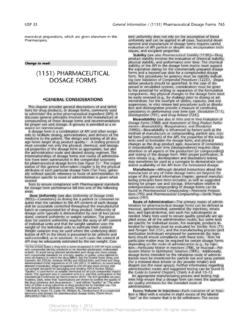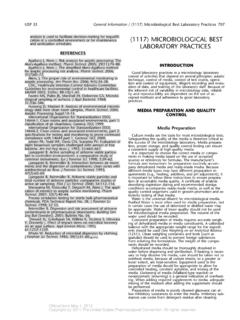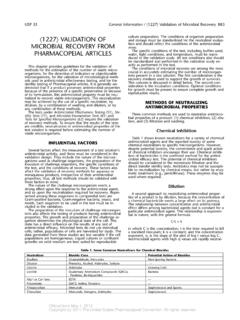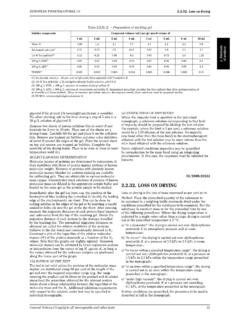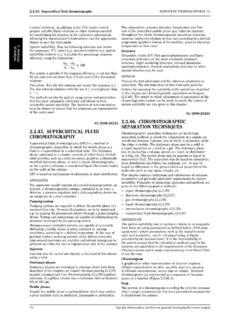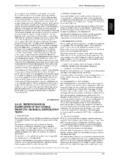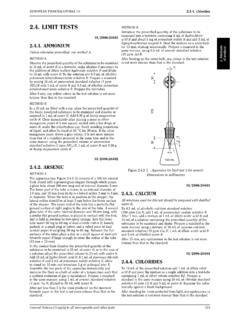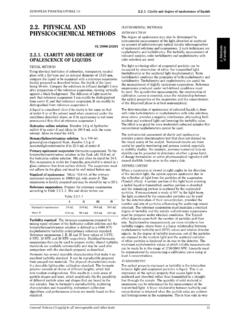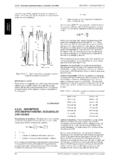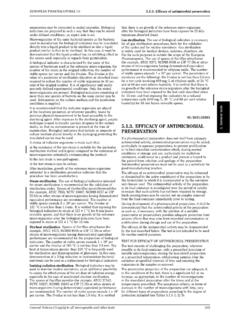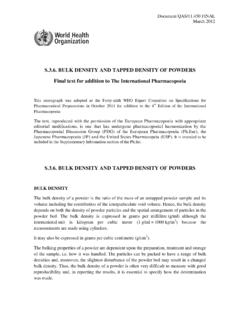Transcription of <401> FATS AND FIXED OILS - DrugFuture
1 Accessed from by nEwp0rt1 on Fri Dec 02 04:09:49 EST 2011 . USP 35 Chemical Tests / 401 Fats and FIXED Oils 163. Requirement There are no more than five fragments visi- (C9H13NO3) in each mL of the Injection taken by the ble. This limit is based on the assumption that fragments formula: with a diameter >50 m are visible to the naked eye. In case of doubt or dispute, the particles are examined micro- ( )( )(AU/AS). scopically to verify their nature and size. in which and are the molecular weights of epinephrine and epinephrine bitartrate, respectively; C is the Self-Sealing Capacity concentration, in g per mL, of USP Epinephrine Bitartrate RS in the Standard Preparation; and V is the volume , in mL, Procedure Fill 10 suitable vials with water to the nominal of Injection taken.
2 volume . Fit the closures that are to be examined, and cap. Using a new hypodermic needle as described above for each closure, pierce each closure 10 times, piercing each time at a different site. Immerse the 10 vials in a solution of (1 g per L) methylene blue, and reduce the external pressure by 27 kPa for 10 minutes. Restore to atmospheric pressure, and leave the vials immersed for 30 minutes. Rinse the outside of the vials. 401 FATS AND FIXED OILS. Requirement None of the vials contain any trace of blue solution. The following definitions and general procedures apply to fats, FIXED oils, waxes, resins, balsams, and similar substances. PREPARATION OF SPECIMEN. 391 EPINEPHRINE ASSAY If a specimen of oil shows turbidity owing to separated stearin, warm the container in a water bath at 50 until the oil is clear, or if the oil does not become clear on warming, pass it through dry filter paper in a funnel contained in a USP Reference Standards 11 USP Epinephrine Bitar- hot-water jacket.
3 Mix thoroughly, and weigh at one time as trate RS. many portions as are needed for the various determinations, Ferro-citrate Solution On the day needed, dissolve using preferably a bottle having a pipet dropper, or a g of ferrous sulfate in 200 mL of water to which have been weighing buret. Keep the specimen melted, if solid at room added mL of dilute hydrochloric acid (1 in 12) and temperature, until the desired portions of specimen are g of sodium bisulfite. Dissolve 500 mg of sodium citrate in withdrawn. 10 mL of this solution, and mix. Buffer Solution In a 50-mL volumetric flask mix g of sodium bicarbonate, g of potassium bicarbonate, and SPECIFIC GRAVITY. 18 mL of water (not all of the solids will dissolve at this stage).
4 To another 18 mL of water add g of amino- Determine the specific gravity of a fat or oil as directed acetic acid and mL of 6 N ammonium hydroxide, mix to under Specific Gravity 841 . dissolve, and transfer this solution to the 50-mL volumetric flask containing the other mixture. Dilute with water to vol- MELTING TEMPERATURE. ume, and mix until solution is complete . Standard Preparation Transfer about 18 mg of USP Ep- Determine the melting temperature as directed for sub- inephrine Bitartrate RS, accurately weighed, to a 100-mL stances of Class II (see Melting Range or Temperature 741 ). volumetric flask with the aid of 20 mL of sodium bisulfite solution (1 in 50), dilute with water to volume , and mix. Transfer mL of this solution to a 50-mL volumetric flask, ACID VALUE (FREE FATTY ACIDS).
5 Dilute with sodium bisulfite solution (1 in 500) to volume , and mix. [NOTE Make the final dilution when the assay is The acidity of fats and FIXED oils in this Pharmacopeia may carried out.] The concentration of USP Epinephrine Bitartrate be expressed as the number of mL of N alkali required RS in the Standard Preparation is about 18 g per mL. to neutralize the free acids in g of substance. Acidity is Assay Preparation Transfer to a 50-mL volumetric flask frequently expressed as the Acid Value, which is the number an accurately measured volume of the Injection under assay, of mg of potassium hydroxide required to neutralize the equivalent to about 500 g of epinephrine, dilute with so- free acids in g of the substance.
6 Unless otherwise di- dium bisulfite solution (1 in 500) to volume , if necessary, rected in the individual monograph, use Method I. and mix. [NOTE The final concentration of sodium bisulfite is in the range of 1 to 3 mg per mL, any bisulfite present in Method I. the Injection under assay being taken into consideration.]. Procedure Into three 50-mL glass-stoppered conical Procedure Unless otherwise directed, dissolve about flasks transfer, separately, aliquots of the Standard g of the substance, accurately weighed, in 50 mL of a Preparation, the Assay Preparation, and sodium bisulfite solu- mixture of equal volumes of alcohol and ether (which has tion (1 in 500) to provide the blank. To each flask add 200 been neutralized to phenolphthalein with N potassium L of Ferro-citrate Solution and mL of Buffer Solution, mix, hydroxide or N sodium hydroxide, unless otherwise and allow the solutions to stand for 30 minutes.)
7 Determine specified) contained in a flask. If the test specimen does not the absorbances of the solutions in 5-cm cells at the wave- dissolve in the cold solvent, connect the flask with a suitable length of maximum absorbance at about 530 nm, with a condenser and warm slowly, with frequent shaking, until suitable spectrophotometer, using the blank to set the in- the specimen dissolves. Add 1 mL of phenolphthalein TS, strument. Calculate the quantity, in mg, of epinephrine and titrate with N potassium hydroxide VS or N. sodium hydroxide VS until the solution remains faintly pink after shaking for 30 seconds. Calculate either the Acid Value Official from May 1, 2012. Copyright (c) 2011 The United States Pharmacopeial Convention.
8 All rights reserved. Accessed from by nEwp0rt1 on Fri Dec 02 04:09:49 EST 2011 . 164 401 Fats and FIXED Oils / Chemical Tests USP 35. or the volume of N alkali required to neutralize g and omitting the further addition of phenolphthalein TS. of specimen (free fatty acids), whichever is appropriate. Cal- Calculate the Ester Value by the formula: culate the Acid Value by the formula: [ (VB VT)N]/W USP35. N/W. in which is the molecular weight of potassium hy- in which is the molecular weight of potassium hy- droxide; VB and VT are the volumes, in mL, of N hydro- droxide; V is the volume , in mL; N is the normality of the chloric acid consumed in the blank test and in the actual potassium hydroxide solution or the sodium hydroxide solu- test, respectively; N is the exact normality of the hydrochlo- tion; and W is the weight, in g, of the sample taken.
9 Ric acid; and W is the weight, in g, of the substance taken If the volume of N potassium hydroxide VS or N for the test. sodium hydroxide VS required for the titration is less than 2. mL, a more dilute titrant may be used, or the sample size may be adjusted accordingly. The results may be expressed HYDROXYL VALUE. in terms of the volume of titrant used or in terms of the equivalent volume of N potassium hydroxide or N The Hydroxyl Value is the number of mg of potassium sodium hydroxide. hydroxide equivalent to the hydroxyl content of g of If the oil has been saturated with carbon dioxide for the the substance. purpose of preservation, gently reflux the alcohol-ether solu- Pyridine Acetic Anhydride Reagent Just before use, tion for 10 minutes before titration.
10 The oil may be freed mix 3 volumes of freshly opened or freshly distilled pyridine from carbon dioxide also by exposing it in a shallow dish in with 1 volume of freshly opened or freshly distilled acetic a vacuum desiccator for 24 hours before weighing the test anhydride. specimens. Procedure Transfer a quantity of the substance, deter- mined by reference to the accompanying table and accu- rately weighed, to a glass-stoppered, 250-mL conical flask, Method II and add mL of Pyridine Acetic Anhydride Reagent. Trans- fer mL of Pyridine Acetic Anhydride Reagent to a second Procedure Prepare 125 mL of a solvent mixture consist- glass-stoppered, 250-mL conical flask to provide the reagent ing of equal volumes of isopropyl alcohol and toluene.
